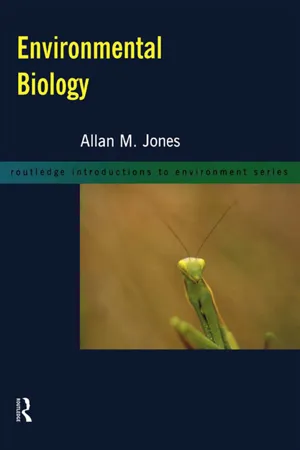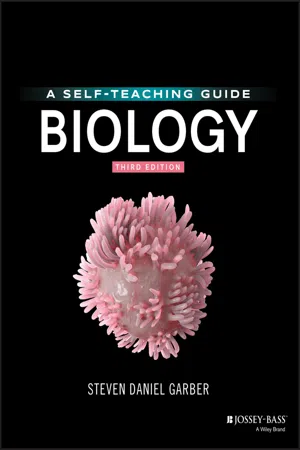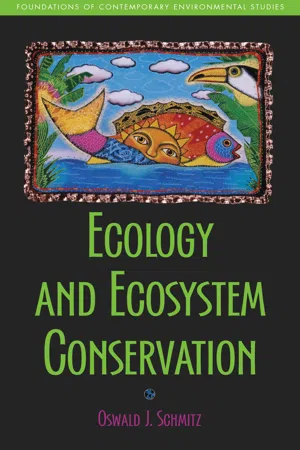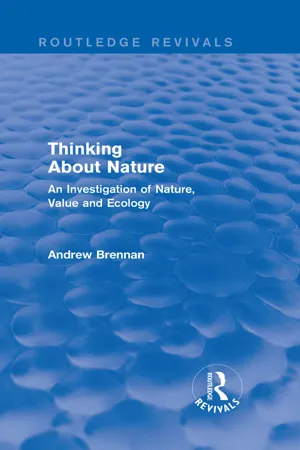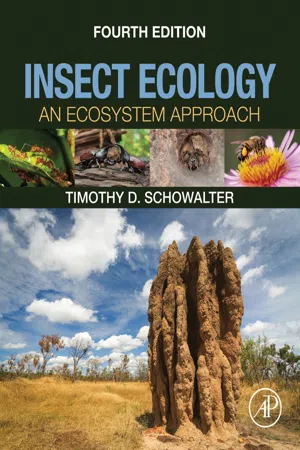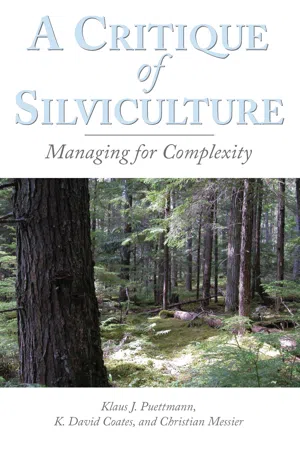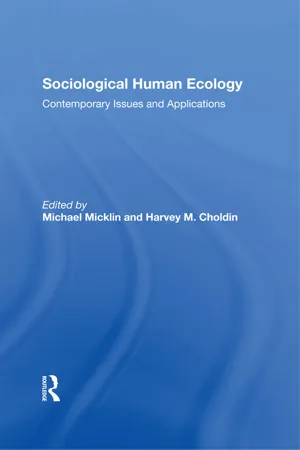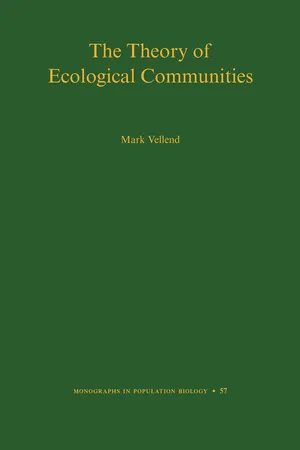Biological Sciences
Community Ecology
Community ecology is the study of the interactions among species within a particular habitat or ecosystem. It focuses on understanding the patterns of species diversity, distribution, and abundance, as well as the processes that influence these patterns. Community ecologists examine how species coexist, compete for resources, and interact with one another, shedding light on the complex web of relationships within ecological communities.
Written by Perlego with AI-assistance
Related key terms
Related key terms
1 of 4
Related key terms
1 of 3
11 Key excerpts on "Community Ecology"
- eBook - ePub
- Britannica Educational Publishing, John P Rafferty(Authors)
- 2010(Publication Date)
- Britannica Educational Publishing(Publisher)
OMMUNITY ECOLOGYC ommunity ecology, or synecology, is the study of the organization and functioning of communities, which are assemblages of interacting populations of the species living within a particular area or habitat. As populations of species interact with one another, they form biological communities. The number of interacting species in these communities and the complexity of their relationships exemplify what is meant by the term “biodiversity.” Structures arise within communities as species interact, and food chains, food webs, guilds, and other interactive webs are created. These relationships change over evolutionary time as species reciprocally adapt to one another through the process of coevolution. The overall structure of biological communities, the organization of interspecific interactions, and the effects the coevolutionary process has on the biological community are described in this chapter.THE BIOTIC ELEMENTS OF COMMUNITIES
Although community structure depends largely on the physical environment, there are four important biotic phenomena that hold communities together. Biotic communities are characterized by the number of trophic levels they can support and how energy moves from one to another. The community is also guided by the establishment of food chains. Often perched at the top of food chains, some members of the community called keystone species have a disproportionate influence over how nutrients and energy move through the ecosystem. Lastly, the habits of groups of species may converge to exploit an ecosystem in similar ways. Such species often compete or cooperate with one another, greatly expanding the number of ways in which species interact and thus contributing to the community’s stability.TROPHIC PYRAMIDS AND THE FLOW OF ENERGYAll biological communities have a basic structure of interaction that forms a trophic pyramid. The trophic pyramid is made up of trophic levels, and food energy is passed from one level to the next along the food chain. The base of the pyramid is composed of species called autotrophs, the primary producers of the ecosystem. They do not obtain energy and nutrients by eating other organisms. Instead, they harness solar energy by photosynthesis (photoautotrophs) or, more rarely, chemical energy by oxidation (chemoautotrophs) to make organic substances from inorganic ones. All other organisms in the ecosystem are consumers called heterotrophs, which either directly or indirectly depend on the producers for food energy. - eBook - ePub
- Simon A. Levin, Stephen R. Carpenter, H. Charles J. Godfray, Ann P. Kinzig, Michel Loreau, Jonathan B. Losos, Brian Walker, David S. Wilcove, Simon A. Levin, Stephen R. Carpenter, H. Charles J. Godfray, Ann P. Kinzig, Michel Loreau, Jonathan B. Losos, Brian Walker, David S. Wilcove, Simon A. Levin, Stephen R. Carpenter, H. Charles J. Godfray, Ann P. Kinzig, Michel Loreau, Jonathan B. Losos, Brian Walker, David S. Wilcove(Authors)
- 2009(Publication Date)
- Princeton University Press(Publisher)
III Communities and Ecosystems Michel Loreau Ecology is the science of the interactions between living organisms and their environment. What makes ecology so fascinating, and at the same time so disturbing for the layperson, is the extraordinary diversity and complexity of these interactions, which create a wide range of nested complex systems from the scale of a droplet of water to that of the entire planet. Anything that happens here and now is almost certain to have an effect elsewhere and later. And this also concerns us as humans. Just as any other species, we transform the world around us by the mere act of living—consuming resources, releasing waste products, changing land and sea for our purposes. But are the effects elsewhere and later predictable? Can we make sense of this complexity, or is it better to just ignore it and to attend to our affairs without worrying about their consequences? Questions of this type are crucial, both for ecology as a science to understand the world in which we live and for society at large to cope with the unforeseen consequences of its past and current actions. Ecology has approached complex ecological systems from two different angles, which have gradually led to two distinct subdisciplines, Community Ecology and ecosystem ecology. A community is a set of species that live together in some place. The focus in Community Ecology has traditionally been on species diversity: What exogenous and endogenous forces lead to more or less diverse communities? How do species interactions constrain the number of species that can coexist? What patterns emerge from these species interactions? An ecosystem is the entire system of biotic and abiotic components that interact in some place. The ecosystem concept is broader than the community concept because it includes a wide range of biological, physical, and chemical processes that connect organisms and their environment - eBook - ePub
- Allan M. Jones(Author)
- 2006(Publication Date)
- Routledge(Publisher)
Communities and ecosystems Key concepts A community is a dynamic and interactive collection of populations. An ecosystem comprises the biological community together with its physical environment. Communities are defined either by the habitat or by the dominant life-forms and occupy a variety of scales. Almost all populations and communities are distributed patchily. Community interactions are founded upon trophic relationships and/or predator–prey relationships. Primary and secondary productivity varies markedly between ecosystems. Changes in composition and form of community vegetation follow distinct patterns known as ecological successions, usually ending with a relatively stable climax community. Biodiversity includes habitat, species and genetic components and is under threat from human activities. Stability of communities and ecosystems is a function of three properties: persistence, constancy and resilience. Biogeographic distributions are the result of both historical (evolutionary) and ecological factors. The previous chapter shows how interactions at population level influence population dynamics, with population characteristics being shaped by environmental pressures, both biotic and abiotic. An ecological community is a dynamic collection of species populations occurring together in space and time within some common, defined habitat or environment; they are integrated or interact so as to influence other component members. The concept originated from the study of plant aggregations (phytosociology) but now applies to all organisms. Most communities include mixtures of members from most kingdoms. Groups of populations forming a community are linked together by a complex range of interactions, directly or indirectly linking all its members together in a web. This web is very much based upon competitive and predator–prey relationships but many of the linkages are very subtle or ephemeral - eBook - ePub
- Laurie Ann Callihan(Author)
- 2013(Publication Date)
- Research & Education Association(Publisher)
CHAPTER 7 Population Biology CHAPTER 7 POPULATION BIOLOGY ECOLOGYEcology is the study of how organisms interact with other organisms and how they influence or are influenced by their physical environment . The word “ecology” is derived from the Greek term oikos (meaning “home” or “place to live”) and ology (meaning “the study of ”), so ecology is a study of organisms in their home. This study has revealed a number of patterns and principles that help us understand how organisms relate to their environment. First, however, it is important to grasp some basic vocabulary used in ecology.The study of ecology centers on the ecosystem. An ecosystem is a group of populations found within a given locality, including the abiotic environment around those populations. A population is the total number of a single species of organism found in a given ecosystem. Typically, there are many populations of different species within a particular ecosystem. The term organism refers to an individual of a particular species. Each species is a distinct group of individuals that are able to interbreed (mate), producing viable offspring. Although species are defined by their ability to reproduce, they are usually described by their morphology (their anatomical features).Populations that interact with each other in a particular ecosystem are collectively termed a community . For instance, a temperate forest community includes pine trees, oaks, shrubs, lichen, mosses, ferns, squirrels, deer, insects, owls, bacteria, fungi, etc.The part of the Earth that includes all living things is called the biosphere . The biosphere also includes the atmosphere (air), the lithosphere (ground), and the hydrosphere (water).A habitat refers to the physical place where a species lives. A species’ habitat must include all the factors that will support its life and reproduction. These factors may be biotic (i.e., living—food source, predators, etc.) and abiotic - eBook - ePub
Biology
A Self-Teaching Guide
- Steven D. Garber(Author)
- 2020(Publication Date)
- Jossey-Bass(Publisher)
15 EcologyEcology is a theoretical, quantitative study of organisms, populations, species, communities, and ecosystems. Both locally and globally, this highly integrative discipline incorporates information, processes, techniques, and data for related fields represented in the previous chapters, as well as inorganic chemistry, organic chemistry, physics, meteorology, geology, soil science, evolution, genetics, immunology, pathology, bioengineering, behavior, and natural history. While all disciplines are interdisciplinary to some extent, few are as interdisciplinary as ecology.The study of the interactions of organisms, with each other and with the environment, is far more complex than we can fully comprehend. However, that doesn't stop us from trying. Ecology began as a pure science, primarily the study of species in their natural habitats, and expanded into a science involved with ecological principles and mechanisms. Much of the theoretical aspect of this field has yet to be used in any practical way. Ecological studies provide a valuable base for all those who plan to enter a field that will potentially affect the environment. It would be much better if far more people studied ecology at some time in their life. Unfortunately, too many children grow up thinking ecology is all about recycling, period. Ecology is far more than just that, and for legislators to ensure that we don't destroy much that lives on our planet, it's important for them to learn that healthy people and healthy communities need far more than a robust economy. We also need to make sure that everyone has access to a healthy, beautiful, vibrant, natural environment. And for species to survive, we cannot just save a small number of parks where everyone goes on vacation. We need places where plants and animals, and fungi and bacteria can live on in perpetuity, without becoming threatened or endangered. I know, that's asking a lot of people. - eBook - ePub
- Oswald J. Schmitz(Author)
- 2013(Publication Date)
- Island Press(Publisher)
This simple container system is a powerful metaphor for the way species assemble and interact in nature.The processes of production and consumption are fundamental to sustaining the functioning of all ecological systems globally. Natural ecological systems differ from the container system in that they are comprised of vastly more species with many more interdependencies than those found in the glass container. Understanding these complex interdependencies is the fundamental purpose of that subfield of biology known as ecology.What Is Ecology?
Ecology is a science aimed at understanding:- The processes by which living organisms interact with each other and with the physical and chemical components of their surrounding environment.
- The way those processes lead to patterns in the geographical distribution and abundance of different kinds of organisms.
Ecosystems encapsulate many forms of biological diversity (also called biodiversity). Biodiversity results from a variety among individuals comprising a species owing to sex, age, and genetic differences among those individuals. It also stems from differences between species living together in a geographic location. For example, species may differ in their functional roles (e.g., plant, herbivore, carnivore) and the efficiency with which each carries out its function in different environmental conditions. Biodiversity also arises from the myriad ways that species are linked to each other in ecosystems. As a consequence of these many forms of biodiversity, there is considerable complexity underlying the structure of ecosystems.The challenge in ecology is resolving this complexity.Biodiversity results from a variety among individuals comprising a species due to sex, age, and ge- netic differences; from differences between species living together in a geographic location; and from the myriad ways that species are linked to each other in ecosystems. As a consequence of these many forms of biodiversity, there is consider- able complexity underlying the structure of ecosystems. The chal- lenge in ecology is resolving this complexity. - eBook - ePub
Thinking about Nature (Routledge Revivals)
An Investigation of Nature, Value and Ecology
- Andrew Brennan(Author)
- 2014(Publication Date)
- Routledge(Publisher)
4 Ecology in Perspective 4.1 Some history Ecology is concerned with species populations as members of communities inhabiting a certain abiotic background in which there may be competition or co-operation. The small number of examples so far given could be multiplied. But to do so would reinforce an impression that should already be obvious. The way organisms fare in what Darwin called the ‘struggle for existence’ will depend on their own characteristics, the characteristics of other organisms around them and the nature of the abiotic context. At levels of organisation above the population, mere may be principles of community structure which explain the distribution of species in a certain area, and the nature of the niches they occupy. One aspect of contemporary ecology not mentioned so far concerns the interactions among very different kinds of species. For example, animal species are on the whole more mobile than plant species. Because bees fly around moderately freely, while the plants they pollinate and feed on are static, we tend to think of bees as utilising plants as resources. But, equally reasonable on a resource model is the notion that bees are resources (pollinators) for plants. So, for example, we could look to see whether certain plant assemblages are organised in such a way as to reduce competition for pollinator service (Armbruster 1986). The examples mentioned so far have involved little dependence on such well known ecological concepts as those of niche, succession, and food chain or food web. These concepts themselves developed as ecology developed from its origins in the study of natural history. Indeed, in 1927 Elton defined ecology as no more man scientific natural history. Nowadays, ecologists would be uncomfortable about accepting such a definition, for it suggests something at once too amateurish and too descriptive - eBook - ePub
Insect Ecology
An Ecosystem Approach
- Timothy D. Schowalter(Author)
- 2016(Publication Date)
- Academic Press(Publisher)
Section III Community EcologyIntroduction Chapter 8: Species Interactions Chapter 9: Community Structure Chapter 10: Community DynamicsPassage contains an image
Introduction
Species co-occurring at a site interact to various degrees, both directly and indirectly, in ways that have intrigued ecologists since the earliest times. These interactions regulate population dynamics, thereby affecting community structure, and also control rates of energy and matter fluxes among organisms, thereby affecting ecosystem function. Some organisms engage in close, direct interactions, as consumers and resources, whereas others interact indirectly in ways that affect activity, such as foraging behavior and reproduction. For example, predation on mimics depends on the presence of their models, and herbivores can be affected by their host’s chemical responses to other herbivores. Direct interactions, that is, competition, predation, and symbioses, have been the focus of research on factors controlling community structure and dynamics, but recent studies have demonstrated that indirect interactions also control community organization. Species interactions are the focus of Chapter 8 .A community is composed of the plant, animal, and microbial species occupying a site. Some of these organisms are integral and characteristic components of the community and help define the community type, whereas others occur by chance as a result of dispersal, foraging, or other movement across a landscape or through a watershed. Particular combinations of species distinguish desert, grassland, or forest communities. Different species assemblages are found in turbulent stream versus lake or in eutrophic versus oligotrophic systems. The number of species and their relative abundances define species diversity, an aspect of community structure that is the focus of a number of ecological issues. Chapter 9 - eBook - ePub
A Critique of Silviculture
Managing for Complexity
- Klaus J. Puettmann, K. David Coates, Christian C. Messier(Authors)
- 2012(Publication Date)
- Island Press(Publisher)
competitive exclusion (Gause 1934), whereby Gause developed mathematical techniques to describe how species that compete for the same resource cannot coexist. The strong mathematical influence in ecology was reinforced by Lotka and Volterra (Begon et al. 2006), whose equations are a standard topic in many ecology classes. The competitive exclusion principle provided ecologists with a mechanism to explain how communities structure themselves. It also allowed a better understanding of the process of succession as species replacing one another as the environment is progressively modified by each set of species.Ecological Niche: Describes the range of habitat conditions that a species or population can occupy within an ecosystem. The niche represents a multidimensional temporal and spatial space, where the biological, physical, and chemical environment is suited for a species. The fundamental niche of a species refers to the range of habitats it can potentially occupy in the absence of interference from other species. The realized niche, which is necessarily narrower, describes the actual range of habitats occupied by the species in the presence of competitors.The central role of niche theory in ecology has been challenged recently by a new concept, the unified neutral theory . It states that species coexistence and patterns of abundance and distribution within ecosystems are governed more by the stochastic processes of extinction, immigration, and speciation than by intrinsic ecological differences of species (Hubbell 1997, 2001; Bell 2000; Fargione et al. 2003; Volkov et al. 2003; Chave 2004). Hubbell’s theory has stimulated new rounds of experimentation to quantify the importance of niche differences (e.g., Gilbert and Lechowicz 2004; Gravel et al. 2006).Unified Neutral Theory: States that autoecological differences between members of an ecological community (e.g., birds, trees, moths, and so on) are much less important for a species’s success than suggested by the niche theory. Instead, it stresses the rate of immigration and speciation and local stochastic (essentially random) processes that cause mortality and regeneration. This theory can be viewed as a null hypothesis for testing the niche theory and claims to better predict the diversity and relative abundance of species in various ecosystems. - eBook - ePub
Sociological Human Ecology
Contemporary Issues And Applications
- Michael Micklin, Harvey M Choldin(Authors)
- 2019(Publication Date)
- Routledge(Publisher)
The question of change in ecosystems brings up what is probably the most questionable assumption in the ecological perspective when it is applied to human ecosystems. The idea that ecosystems follow a unilinear path of development, culminating in a “climax community” characterized by stable interdependence, was mentioned earlier. While models of social change based on evolutionary concepts have once again become popular with social scientists (e.g., Sahlins and Service, 1960; Parsons, 1966; Adams, 1975; Lenski, 1979; Lenski and Lenski, 1978) they do not posit specific stages of development and leave as an open question the end-point of the evolutionary process. Indeed, twentieth century trends in relationships between humankind and its environment suggest anything but progression toward a balanced, climax relationship (Catton, 1978).The applicability of ecological concepts for the social sciences is the next issue to be considered. As pointed out earlier, the ecological perspective focuses primarily on populations, environments, and their interrelationships. The concept of a population refers to any aggregate defined in terms of at least one common characteristic, but those of concern to ecologists also involve two additional features: territoriality and interaction. Social scientists study a great diversity of populations, although the most common are groups, organizations, communities, and societies.In contrast, the environment concept is much less developed in the social sciences. A distinction between physical and social environments is common, though much greater attention has been given to the latter. Only in recent years have social scientists given serious attention to the nonsocial environment, but there are exceptions to be found among some disciplinary specialties, e.g., resource economics, physical geography and, not surprisingly, human ecology. Nevertheless, there has been a long-standing recognition that the organization of human populations is, to some extent, a response to environmental constraints and possibilities. - eBook - ePub
- Mark Vellend(Author)
- 2016(Publication Date)
- Princeton University Press(Publisher)
Figure 4.1. The filter model of community assembly. In this hypothetical example, a random subset of species in the regional pool has access to a local site; only species with rounded edges can tolerate the abiotic conditions; and competition leads to the elimination of all but one species of each functional type (shape). The two remaining species can coexist stably given contrasting resource requirements.The debate over whether the pursuit of ecological laws should be a central goal of our science, or whether it should be abandoned, has persisted for a long time (MacArthur 1972, McIntosh 1987, Shrader-Frechette and McCoy 1993, Lawton 1999, Cooper 2003, Simberloff 2004, Scheiner and Willig 2011). Importantly, the terms of the debate typically involve an implicit assumption that processes must be considered in the way I have just described—that is, a general theory of ecological communities must involve factors like climate, disturbance, dispersal, predation, competition, and mutualistic interactions. However, one can think about ecological processes at different levels. For example, the processes that determine changes over space and time in allele frequencies in populations are largely ecological in nature (mutation is the only exception), and as described in the next section, population geneticists have approached things quite differently than ecologists.4.3. THE THEORY OF POPULATION GENETICS: HIGH-LEVEL PROCESSES
Index pages curate the most relevant extracts from our library of academic textbooks. They’ve been created using an in-house natural language model (NLM), each adding context and meaning to key research topics.
Explore more topic indexes
Explore more topic indexes
1 of 6
Explore more topic indexes
1 of 4


